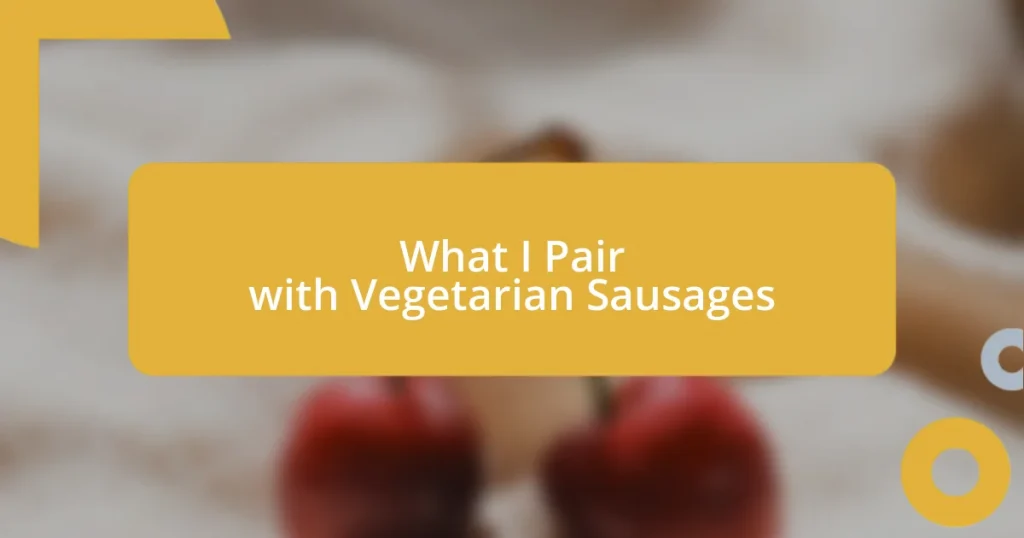Key takeaways:
- Sous-vide cooking ensures precise temperature control, resulting in perfectly cooked sausages that are consistently juicy and flavorful.
- Choosing the right type of sausage, considering factors like fat content and casing, enhances the sous-vide experience and flavor integration.
- Successful sous-vide preparation involves proper seasoning, vacuum-sealing techniques, and post-cooking finishing touches like searing for added texture and flavor.
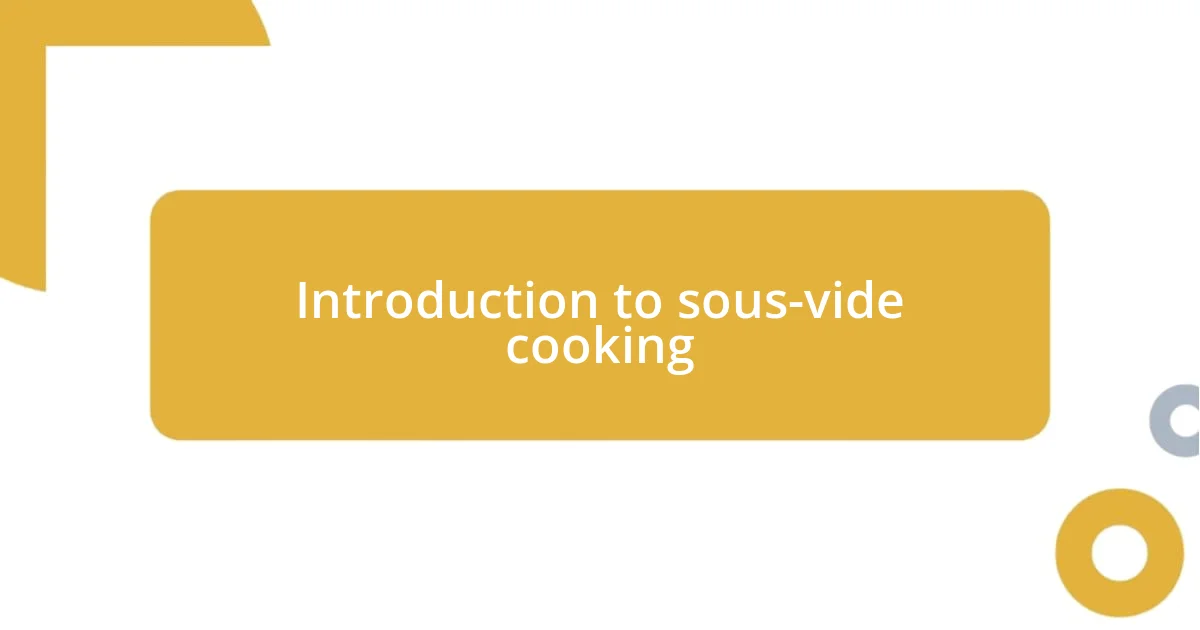
Introduction to sous-vide cooking
Sous-vide cooking is a technique that has revolutionized how many of us approach food preparation. Imagine a method where you can cook your meals to perfection, with precise temperature control for hours on end. The first time I tried sous-vide, I was amazed by how tender and flavorful my steak turned out, and I couldn’t help but wonder, could this technique elevate my sausage-making game too?
In sous-vide, food is vacuum-sealed in bags, allowing it to cook evenly in a water bath at a constant temperature. This method not only preserves flavors but also enhances textures in a way that traditional cooking often falls short. I remember when I introduced this method to a family dinner; the disbelief on their faces as they tasted the perfectly cooked veggies was priceless. Isn’t it fascinating how a simple shift in approach can transform familiar ingredients into something extraordinary?
I think what I find most appealing about sous-vide is the ability to set it and forget it. Whether I’m prepping for a busy week or just want to impress friends during a dinner party, the hands-off approach allows me more time to relax or focus on other dishes. Have you ever felt overwhelmed in the kitchen? Sous-vide can be your ally, giving you the freedom to enjoy the process without the chaos.
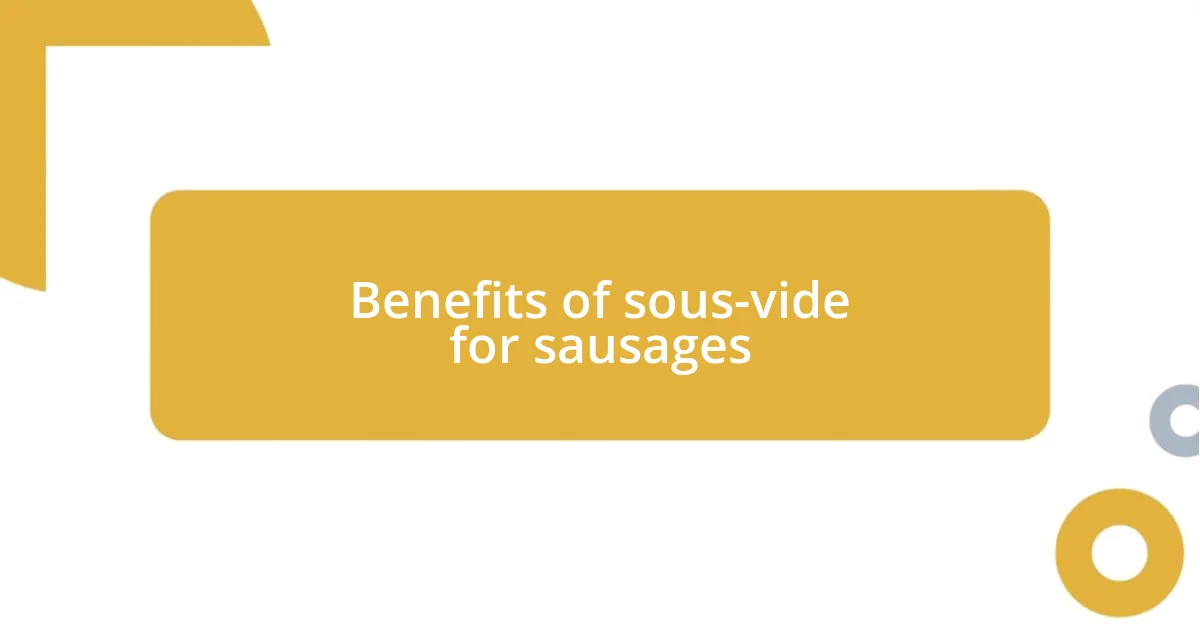
Benefits of sous-vide for sausages
Sous-vide cooking brings a unique advantage to sausage-making that I truly appreciate. By maintaining a precise temperature, I’ve found that the sausages retain their juiciness and flavor in ways that other methods often can’t achieve. The first time I prepared sausages using sous-vide, I was struck by how the flavors melded beautifully and developed a depth I hadn’t experienced before.
Here are some compelling benefits of sous-vide for sausages:
- Consistent Results: Every sausage comes out perfectly cooked, eliminating hot spots or dryness.
- Enhanced Flavor: The vacuum-sealing process ensures that marinades and spices infuse deeply into the sausage.
- Tender Textures: The low-and-slow cooking method makes even tougher cuts incredibly tender.
- Meal Prep Made Easy: You can cook sausages in advance and store them for later, minimizing last-minute stress during meal times.
- Versatility: Sous-vide allows for experimenting with various seasonings and ingredients without the fear of overcooking.
I still remember the thrill of serving those sous-vide sausages at a backyard barbecue. The way everyone complimented them, raving about the juicy, flavorful bites, made me feel like a culinary genius. Cooking them in this method not only elevated my sausage game but also transformed the overall dining experience for my guests.

Choosing the right sausages
Choosing the right sausages is a crucial step in elevating your sous-vide game. Different types can yield varying results, depending on their ingredients and casings. For instance, I’ve noticed that fresh sausages often absorb flavors better during the sous-vide process, while fully cooked sausages tend to maintain their taste integrity, creating an impressive backdrop for your seasonings. Have you ever tried to experiment with different styles? I really enjoyed the journey of discovering how spiced or herbed sausages transformed in flavor when cooked sous-vide.
When selecting sausages, consider their fat content: higher fat levels usually lead to a richer taste and juiciness. Personally, I prefer sausages with about 20-30% fat; they come out so succulent and packed with flavor. Plus, keep in mind the casing. Natural casings perform better as they can withstand the sous-vide process without breaking down. I remember being pleasantly surprised the first time I tried lamb sausages — the rich, savory flavor combined with herbs just sang after that gentle bath in the water bath.
Ultimately, quality matters. I often scout local butcher shops for artisan sausages, which can provide unique flavor profiles that supermarket options simply can’t match. I love supporting small businesses, and it allows me to experiment with unusual varieties that spark creativity in my cooking. Do you have a favorite type of sausage? Exploring local options can lead to delightful surprises that make each sous-vide experience memorable.
| Type of Sausage | Ideal Use in Sous-Vide |
|---|---|
| Fresh Sausages | Best for enhanced flavor integration; absorbs spices well. |
| Fully Cooked Sausages | Maintains taste integrity; great for convenience. |
| Lamb Sausages | Brings richness; works beautifully with herbs. |
| Pork Sausages | Classic choice; juicy and versatile. |
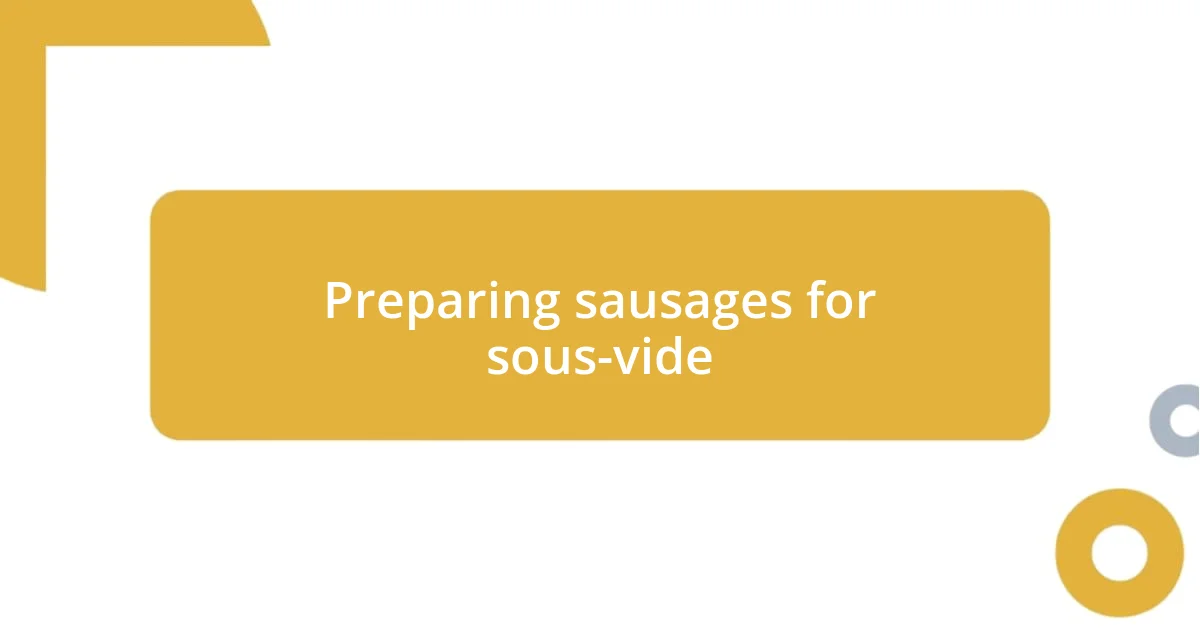
Preparing sausages for sous-vide
When it comes to preparing sausages for sous-vide, I find that the first step is all about seasoning. I remember one time I thought I could skip this part, only to end up with bland sausages that missed the mark. Now, I always take the time to mix my spices and herbs directly into the meat, allowing the flavors to infuse deeply during the cooking process. Have you ever tried a combination that surprised you? A hint of smoked paprika can really transform the taste!
Next, it’s essential to vacuum-seal your sausages properly. I learned the hard way that air pockets can lead to uneven cooking. I always double-check that my bags are tightly sealed, ensuring no air gets in. This meticulousness pays off in spades when the sausage comes out perfectly tender and flavorful. Plus, I often label my bags with the cooking time and temperature. This little habit keeps me organized, making it easier to replicate results or try new flavors in the future.
Once they’re prepped and sealed, I’ve noticed that the actual sous-vide process is almost meditative. As I set the water bath to the precise temperature, I feel a sense of anticipation. It’s like waiting for a gift to be unwrapped. The first time I bit into a pork sausage cooked for a solid hour at 160°F (71°C), I was hooked — the texture was sublime, and the burst of flavors was unlike anything I’d had before. Have you experienced that moment when it all comes together? Preparing sausages for sous-vide can be a little ritual that adds excitement to your cooking journey!
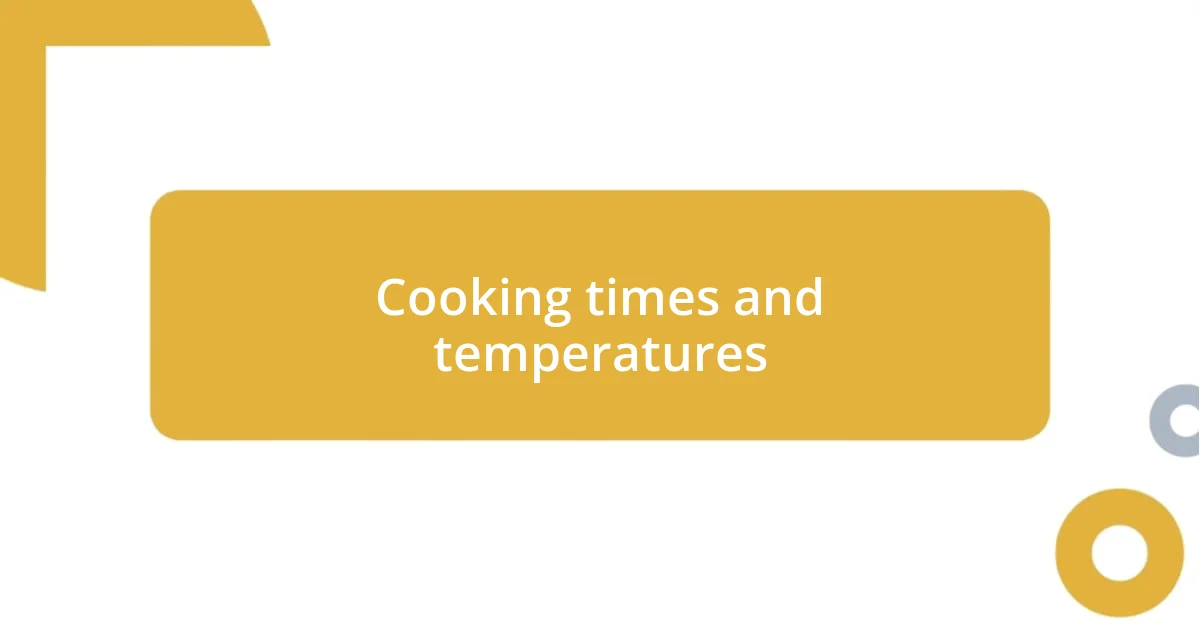
Cooking times and temperatures
Cooking sausages sous-vide is all about getting the timing and temperature just right. I’ve experimented a lot, and I’ve found that cooking fresh sausages at 145°F (63°C) for about 1.5 to 2 hours gives you a tender and juicy result. When I first tried this, the incredible flavor was a revelation, like a well-kept secret that made my taste buds dance!
For fully cooked sausages, a temperature of around 140°F (60°C) for 1 hour works beautifully. I remember the first time I cooked a smoked sausage this way. When I bit into it, I was amazed at how the gentle heat rejuvenated the flavors, making it so much more vibrant compared to just heating it up in a pan. Have you felt that thrill when a familiar food surprises you in a new way?
It’s worth noting that longer cooking times can break down the texture more, especially for sausages with higher fat content. Personally, I’ve found that cooking pork sausages at 160°F (71°C) for about an hour ends up producing a well-balanced, succulent bite. Striking the right balance between time and temperature really seems to elevate the entire dish, doesn’t it? It’s like a culinary symphony where each element plays its part to perfection!
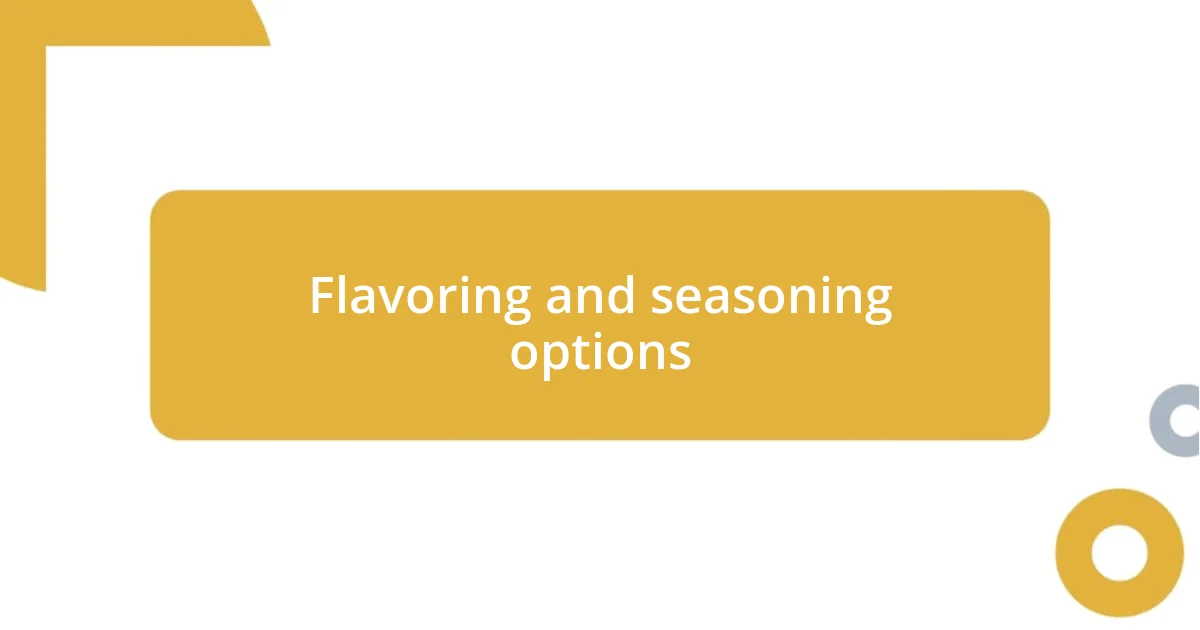
Flavoring and seasoning options
When it comes to flavoring sausages for sous-vide, I truly believe that the magic lies in the details. One of my favorite combinations is garlic, thyme, and fennel seeds. I remember the first time I tried this mix; it was like a burst of herby goodness with a hint of sweetness. Have you ever thought about how the right spices can elevate a simple meal to something memorable?
I’ve also learned that adding a splash of liquid can take the seasoning to a new level. Whether it’s a touch of balsamic vinegar or a splash of apple cider, these additions can deepen the flavor profile significantly. I once experimented with a bit of beer in my sausage mix, and the result was astonishing! It brought a richness that I never imagined possible. Isn’t it fascinating how a simple tweak can transform the ordinary into the extraordinary?
Let’s not forget about the art of marinating. Before sealing your sausages, letting them rest in a mixture of herbs and spices can really work wonders. I recall preparing a batch with a spicy chili rub; the anticipation built as I waited. When I finally tasted them after sous-viding, the intensity of flavor was wonderfully pronounced. Have you tried marinating your sausages before sous-vide? It’s like giving them an extra layer of love that truly shines through in every bite.
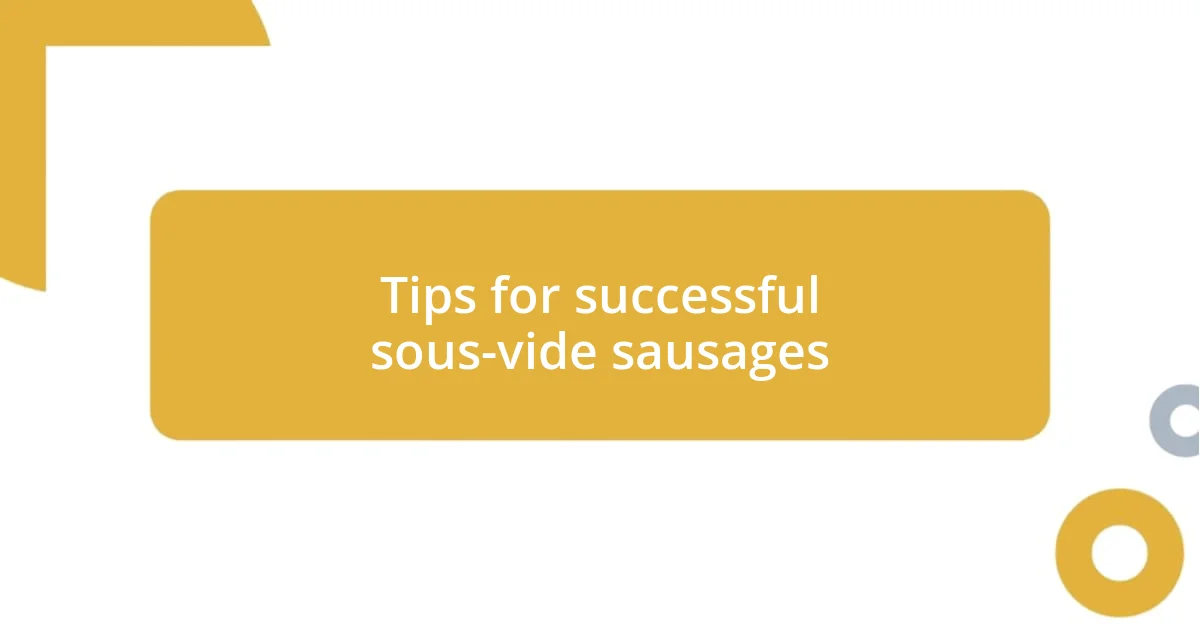
Tips for successful sous-vide sausages
Using the right packaging is essential for successful sous-vide sausages. I prefer vacuum-sealing them, as it ensures a tight fit that prevents water from seeping in. The first time I used a Ziploc bag with the air pressed out, I had some unexpected leakage, which was a bummer. Have you ever had that happen? It’s so disappointing when the water dilutes the wonderful flavors you’ve worked to create.
Another key tip involves the placement of your sausages in the water bath. I’ve learned that arranging them in a single layer helps maintain even cooking, making sure every sausage gets that perfect sous-vide touch. When I stacked them before, I ended up with uneven textures. Can you imagine biting into one that’s cooked perfectly, while another is overdone? It’s like the difference between night and day in flavor and satisfaction.
Lastly, don’t skip the finishing steps! After sous-viding, giving your sausages a quick sear on a hot grill or skillet adds a gorgeous caramelization. I remember the mouthwatering aroma filling my kitchen after finishing a batch this way. Isn’t it magical how that crispy exterior can elevate the entire experience? The contrast between the juicy interior and the charred edges is a game changer!















